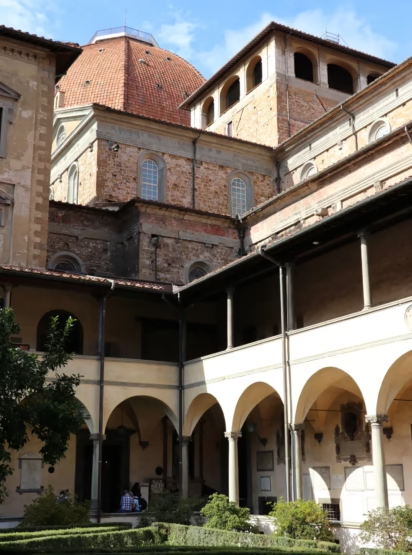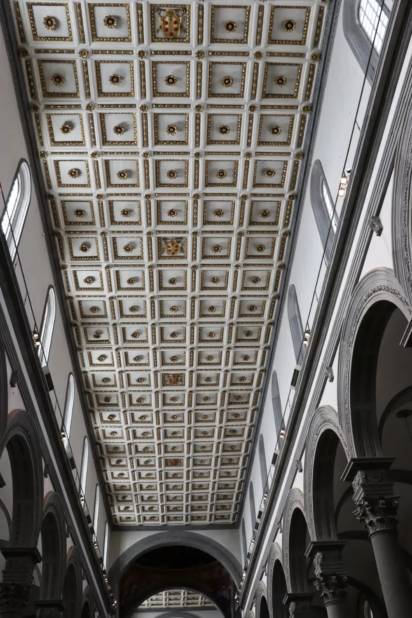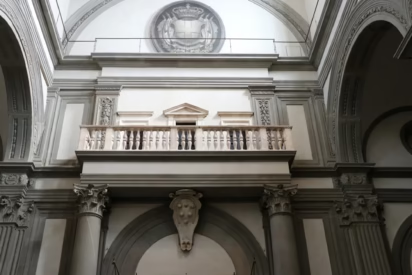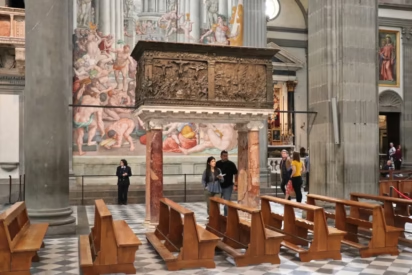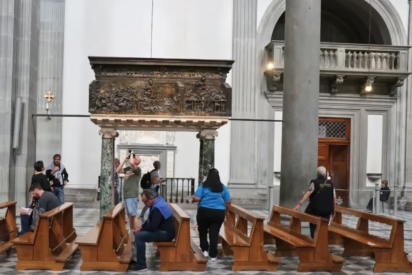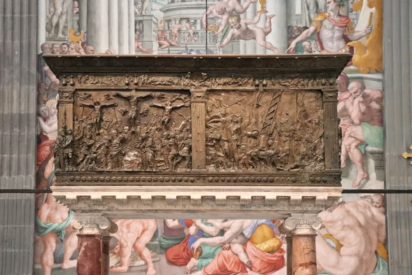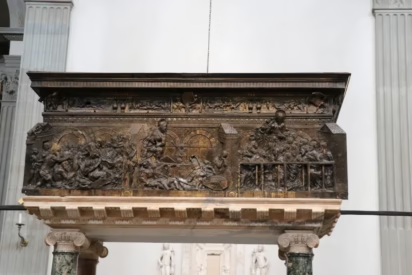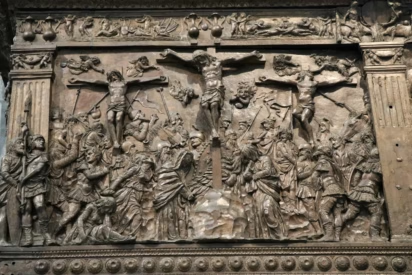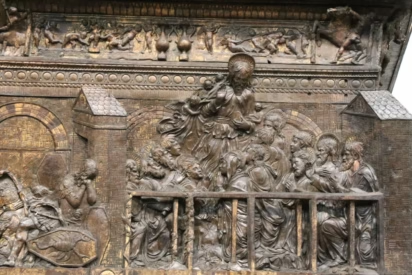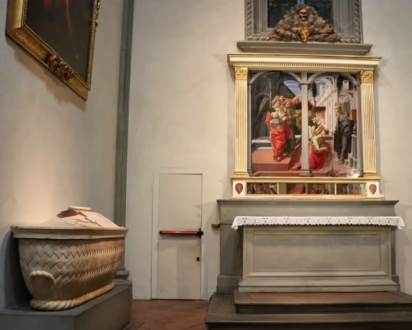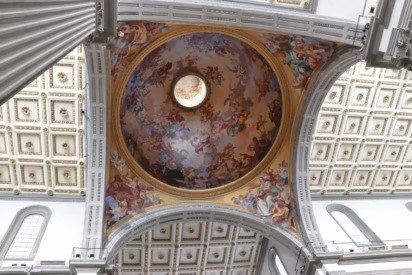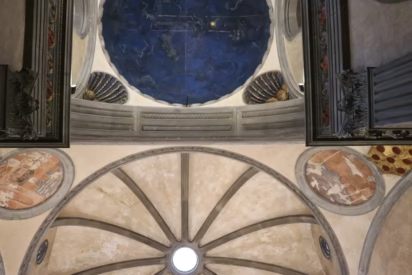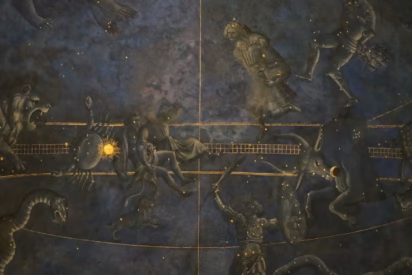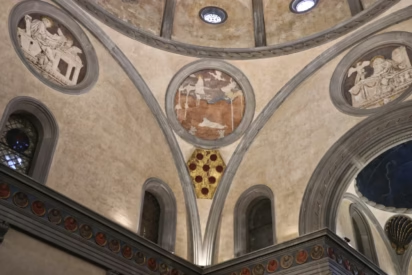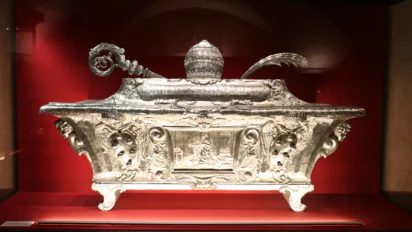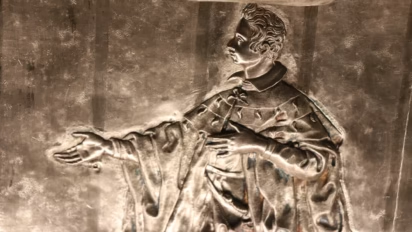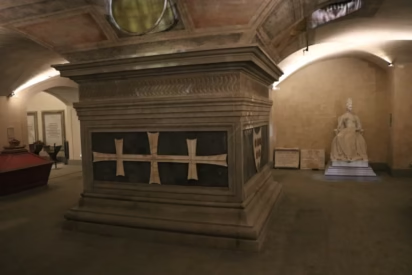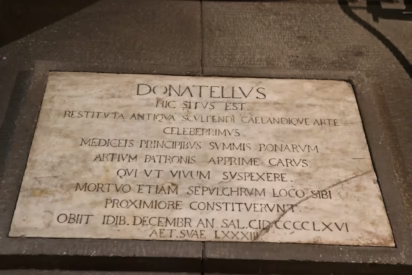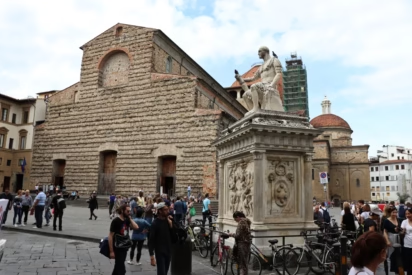The Basilica of San Lorenzo is at the origins of the Florentine Renaissance with the tombs of the Medicis and sculptures by Donatello and Michelangelo in this magnificent church in the heart of Florence.

Although the church of San Lorenzo has some credible claims to being the oldest church in Florence, the present basilica is the third church here and dates from the Renaissance period. The church has several claims to fame including the first Renaissance building (designed by the talented Brunelleschi), both architecture and art by Michelangelo, the final works by Donatello, being still without a western facade, and above all the tombs of the Medicis (with some of the best Michelangelo sculptures in Florence). The Laurentian Medici Library was designed by Michelangelo and preserved most of its 16th-century interior unaltered. The Firenze Card is a great time-saver with skip-the-line access to all parts of the San Lorenzo complex. Guided tours are also available.
→ Top museums, churches, and sights in Florence are open mostly as normal in 2025 — see 2025: Florence Opening Hours of Top Sights, Museums, and Churches for the latest information and opening hours. The Firenzecard is again sold while the Turbopass Florence City Pass is a good alternative that includes online timeslot reservations for both the Uffizi and Accademia.
Visiting the San Lorenzo Basilica and Medici Chapel
The following four main venues are seen when visiting the Basilica of San Lorenzo in Florence:
- Basilica San Lorenzo — the magnificent Renaissance church with the old sacristy, often considered the first Renaissance-designed space.
- Crypt — with treasury and the graves of Cosimo the Elder and Donatello.
- Cappelle Medicee — Medici Chapels with the sarcophagi of most major Medici family members and the New Sacristy designed by Michelangelo with some of his best sculptures in Florence.
- Biblioteca Medicea Laurenziana — the Medici’s library designed by Michelangelo.
See details of the separate opening hours and tickets below. The Basilica, Medici Chapels, and Laurentian Library have different opening hours and tickets. The Firenze Card is valid.
Basilica of San Lorenzo in Florence
The Basilica of San Lorenzo may lay some claims to being at the site of the oldest Christian church in Florence. The first church here was consecrated in 393 AD by St Ambrose but at that time, this area was still outside the city limits.
The current triple-nave Renaissance basilica replaced an earlier Romanesque church during the 15th century. San Lorenzo was the parish church of the powerful Medici family and they not only financed the basilica but also chose to build a monumental chapel in the apse for their elaborate and flamboyant mausoleum. The Medici family shield is frequently seen in detailing throughout the church.
The Old Sacristy was designed by Filippo Brunelleschi in 1419 and was completed by 1429. It is generally considered to be the first Renaissance building ever. Brunelleschi also designed the main basilica but most of it was only completed with some modifications after his death.
The relatively uncluttered Renaissance style allowed for a beautiful, airy church with magnificent proportions. The large nave is mostly white with only grey used for the pillars and detailing. Brunelleschi used this design to alter the general perspective and focus the attention on the high altar. (The High Renaissance Medici Chapel, in contrast, left no wall space unadorned.)
The inner facade of the western end features a marble and stone Reliquary Tribune by Michelangelo. He designed a much more monumental marble external facade for the church but this was never erected — to the present day the external western facade of St Lorenzo remains an unadorned, rough surface.
The large cupola over the Medici Chapel is the most prominent external feature of the church. In Florence, it is second in size only to the magnificent cupola Brunelleschi designed for the nearby Duomo.
Art in San Lorenzo in Florence
The church of San Lorenzo is filled with art from all eras from the Middle Ages to the present. Many works are Baroque but the Renaissance items are of particular note.
Donatello Pulpits in San Lorenzo
San Lorenzo has many works by Donatello but the highlights are the two bronze pulpits in the nave — the final works of this Renaissance master, who is buried in the crypt of this church. The reliefs show Donatello’s experience and knowledge of perspective and how to work multiple scenes and many characters into a relatively small and flat space. (The marble pulpits in nearby Pisa are also impressive for the number of characters used — Niccola Pisano’s in the Baptistery and Giovanni Pisano’s in the Duomo di Pisa.)
These bronze panels were originally part of the choir loft and were only assembled in 1515 as a pulpit and only placed on top of marble columns as late as the second half of the 16th century when further reliefs were added.
The Passion Pulpit (on the northern side of the church in front of the large Martyr of St Lawrence fresco) depicts scenes from the Agony in the Garden, Christ Before Pilate and Caiphas, Crucifixion, Deposition from the Cross, and Entombment. The Resurrection Pulpit scenes include the Three Marys, Descent into Limbo, Resurrection, Ascension, Pentecost, and the Martyrdom of St Lawrence.

The polychrome marble choir loft near the Martyrdom painting is also by Donatello and his workshop.
Paintings in San Lorenzo in Florence

The Basilica of San Lorenzo has a large number of paintings ranging from the 15th century to the present. Many are in the side chapels, which were made shallower than Brunelleschi intended. He wanted them square similar to the ones in the transept built while he was still alive.
Note particularly the Marriage of the Virgin (1523) by Rosso Fiorentino (second chapel from the rear, south). This mannerist painting shows Mary and Joseph as young and ordinary people. (Michelangelo followed a similar approach in his famous round painting now in the Uffizi.)
The large mannerist fresco of the Martyrdom of St Lawrence (1565-8) is by Bronzino. It shows a lot of flesh but remarkably no exposed genitals. According to legend, St Lawrence, one of the deacons of Rome, was roasted alive on a gridiron in AD258.
Many historians believe a simple spelling mistake led to the belief that St Lawrence (San Lorenzo) was roasted rather than decapitated, as was the normal punishment used against others during the same persecution. However, the legend is well established and the gridiron is generally used as the symbol of St Lawrence. Rather morbidly he is considered the patron saint of amongst others cooks and chefs but also librarians and comedians.
Martelli Chapel in San Lorenzo
Arguably the best painting in the church is The Annunciation and Stories from the Life of St Nicholas (1440-7) by Filippo Lippi. This masterpiece was painted for the Martelli Chapel where it still remains today.
The elegant white marble coffin for the tomb of Niccolo and Fioretta Martelli is by Donatello (1464). On the opposite wall is a Cenotaph to Donatello. It is a historicist work (1896) by Dario Guidotti and Raffaello Romanelli.
The actual remains of Donatello are in the crypt of the church. (Santa Croce has similar historicist cenotaphs that sometimes struggle to compete in quality with the originals.)
Crossing and Tomb Stone for Cosimo the Elder
In the crossing, in front of the high altar, is the marble and porphyry tomb slab of Cosimo the Elder — his sarcophagus is directly underneath in the crypt. Most of the other senior Medicis are honored in the mausoleum in the Medici Chapels attached to this church (but now only accessible from an external door).
The interior of the dome at the crossing is painted with a fresco showing Florentine Saints in Glory (1742) by Vicenzo Meucci.
Brunelleschi’s Old Sacristy
The old sacristy is the oldest part of the current church. It was designed by Brunelleschi in 1419 according to the strict geometrical harmony of the square and circle. It is often considered the first Renaissance building ever built.
Here, the cube symbolizes the earthly world while the sphere on top the heavens. The gold and lapis lazuli fresco in the chancel dome shows the sky over Florence on 4 July 1442.
Much of the interior decorations and painted terra-cotta sculptures are by Donatello. The emphasis here is on St John the Evangelist but also includes depictions of the Medici family’s patron saints — St Cosmas and St Damian.
The fine bronze doors are by Donatello. They are great works of art but not as old as the Bonanno doors in Pisa (1180), or as good as the bronze doors Lorenzo Ghiberti made for the baptistery in Florence (originals in the Duomo Museum).
The old sacristy was intended as a mausoleum for the Medicis. The sarcophagi and tombs are for Medicis, including the father and uncle of Lorenzo the Magnificent.
The New Sacristy at the opposite end of the transept was designed by Michelangelo. It is part of the Medici Chapel and cannot be accessed from inside the church.
Crypt and Treasury of San Lorenzo
The crypt of San Lorenzo houses the treasury, as well as the graves of Donatello and Cosimo the Elder. The crypt is accessed from the cloisters to the north of the church. (Entrance to the left when facing the facade-less church.)
The treasury has the usual collection of religious paraphernalia, furnishings, and reliquaries. It is worth having a closer look at the detailing on some of the items on display to see magnificent craftsmanship. The Medici shield appears with regularity.
For many, the main draw of this crypt is the two graves. The large Renaissance sarcophagus built into the pillar that supports the high altar of the basilica contains the remains of Cosimo the Elder, who died in 1464. At Cosimo’s request, his friend Donatello, who died only two years later, was also buried in this crypt. The marble commemorative plaque was crafted around three centuries later.
Biblioteca Medicea Laurenziana

The Biblioteca Medicea Laurenziana, a beautiful Renaissance library designed by Michelangelo for the Medicis, is on the upper level of the galleries in the cloister. The original 16th-century reading room survived to the present.
→ See the Laurentian Medici Library for more details. (Note separate tickets and opening hours — only weekday mornings — from the rest of the San Lorenzo complex!)
Medici Chapels in San Lorenzo

The Chappelle Medicee is like a huge apse on the east side of the San Lorenzo Basilica but currently only accessible through an external door.
A visit to this national museum includes the crypt where the Medicis remains actually are, the monumental princes’ chapel with six huge sarcophagi, and the new sacristy designed by Michelangelo and with several of his best sculptures in Florence.
→ See Visit the Medici Chapels for more details — note separate tickets and mostly shorter opening hours.
Visitor’s Information for San Lorenzo in Florence
The Basilica of San Lorenzo and crypt are open Monday to Saturday from 10:00 to 17:30. The church is closed for tourist visits on Sunday (but sometimes open in the afternoon in summer).
Admission to the church and crypt is €9 and free for under 12-year-olds.
Buy tickets in the cloisters — entrance to the left of the church when facing the unfinished facade. It is usually necessary to visit the Basilica first and then the crypt.
Combination tickets with the Laurentian Medici Library were not available in recent years. Tickets are sold at the same window (but note the shorter opening hours of the library).
Admission to the Medici Chapels is completely separate — skip-the-line tickets are available online.
The Firenze Card is valid at all sights in the San Lorenzo complex — skip the ticket window and go directly to the entrances. Keep the paper ticket issued at the basilica door to visit the crypt — reverse order visits are not possible.
More Articles on Florence Sights
The high season in Florence is increasingly long: Easter, May, July, August, and the Christmas holidays are especially busy. November and January to mid-March are the only quiet months, except for the February school holiday week. Plan and book time-slot reservation tickets and tours when available in advance — the Accademia and the Uffizi are again sold out weeks in advance. Top sights are quieter directly at opening time or in the late afternoon.
→→ Opening hours for top sights in 2025 — most sights have long hours but advance time-slot reservations are always sensible.
- Tips on Buying Tickets for the Uffizi Museum
- Tips on Buying Skip-the-Line Tickets for the Accademia (Michelangelo’s David)
- See Michelangelo’s David in the Galleria dell’ Accademia
- Visit the Duomo sights: Cathedral (Duomo), Baptistery (Battistero), Bell Tower (Campanile), Dome (Cupola), Museum (Museo), and Tickets + Opening Hours
- Visit the Bargello Museum of Sculpture (Donatello’s Davids)
- Visit San Marco Museum to see the frescoes and altarpieces painted by Fra Angelico.
- Visit Santa Maria Novella Church and Museum to see medieval and Renaissance Art.
- Visit Santa Croce for Giotto Frescoes and Michelangelo’s Grave
- San Lorenzo complex: Visit the Basilica for Renaissance Art, See the Laurentian Medici Library by Michelangelo, and Visit the Medici Chapels (Michelangelo Statues)
- Visit the Orsanmichele Church and Museum with sculptures.
- Save on Sightseeing in Florence with the Firenze Card (again available but not including transportation or the Duomo sights, or consider the Turbopass Florence City Pass that includes online timeslot reservations for both the Uffizi and Accademia.
- Travel to Pisa to see the Field of Miracles and the Leaning Tower of Pisa.
- Visit the magnificent Romanesque-Gothic cathedral in nearby Siena.
- Save on top Italian designer fashion at The Mall Factory Outlet Stores.
Florence Resources
- The official website of the Firenze Tourist Office is a bit cumbersome but has very useful information. Especially the pdf (alternative link) with the opening hours of all major sights. Unfortunately, it is only available for the current month but it is the second last line on opening hours — the final say is the guard at the door, NOT the ticket window!
- Get Your Guide offers tours of all major sights while Tiqets sells online tickets for many top sights in Florence.
- Book luggage storage online and explore Florence more easily on foot.
- Trainline is good for booking online train tickets in Italy and most of Europe.
